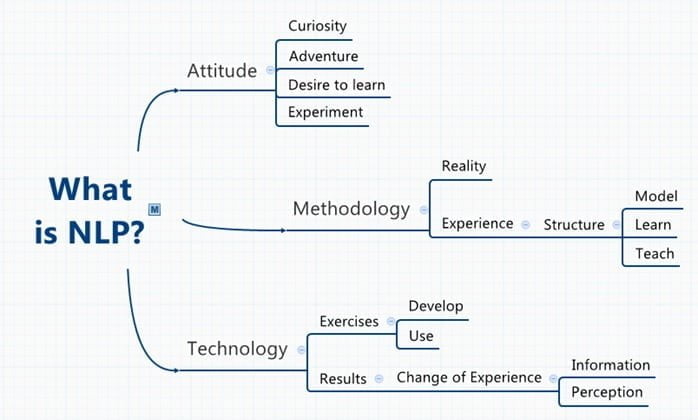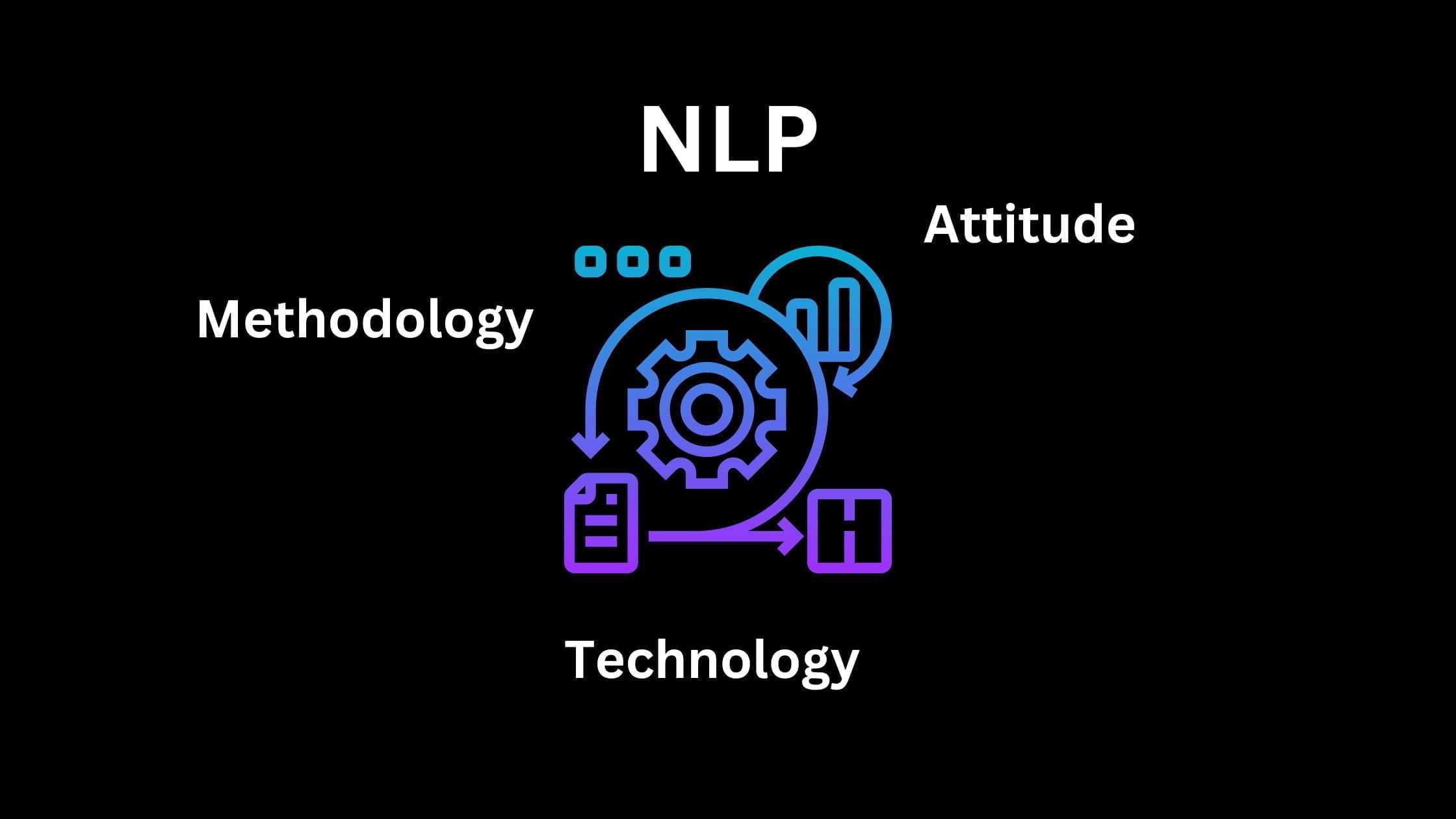Understand what is NLP or neuro-linguistics Programming. NLP is an evolving body of knowledge that models human excellence so that behaviors leading to personal growth can be easily adopted.
What is NLP this body of knowledge can be understood in many different ways until you actually start to experience the benefits.
NLP is a Way of Looking at the world
We live in a common outer world, but our inner worlds can be very different. We give meaning to our world depending on the way we think. This body of knowledge wants to lead us to personal excellence by providing us with the tools to look at the world in the NLP way.
There is a difference between our perception and our perspective and they influence each other.
NLP is an Acronym for Neuro-Linguistic Programming
The name NLP describes the interconnectedness of our neurological processes (Neuro) to language (Linguistic) and that these processes have a particular organization (Programming) that affects our behavior.
Neuro:
We interact with the world through the 5 senses. The external reality is processed by our five senses and nervous system into our subjective experience.
Neuroscience is the scientific study of the nervous system, its functions, and disorders. The nervous system includes the brain, spinal cord, and peripheral nervous system. It is like the human system’s hardware.
Neuro in NLP relates to the subjective experience, whereas neuroscience deals with objective reality.
The name NLP symbolizes the form of mental programs or our Neurological experiences sorted and interpreted through structured communication.
Linguistic:
We give meaning to what we see, hear, touch, smell, and taste. Our experience is coded, organized, and given meaning by the language and non-verbal communication cues we express.
Through verbal and nonverbal communication we share our experiences with others.
NLP stands for Neuro (mind) Linguistic (language) Programming. This literally means the use of language or linguistic aspects to change the programming of the mind. The Neuro literally means the neurocircuitry that represents the mind. Programming represents the ability to change our behaviors.
NLP describes how to recognize, use and change mental programming.
Programming:
Once we understand the structure of the experience we can look at
- What do we do with the sensory experience?
- Why do we give the meaning that we give to an experience?
- Why do we behave the way we do?
Based on the study of the structure of subjective experience we can then understand how people know
- What do they know?
- What do they do?
- How can we change what we do?
NLP is a Useful Pseudoscience for Personal Growth
NLP is not a science. It is considered a pseudoscientific approach to communication, psychotherapy, and personal development.
There is no full-proof scientific evidence favoring NLP because it is very subjective. Yet it is practiced as it is very effective and useful. Personal results are obtained depending on how much open one is to experiential learning and doing the activities rather than analyzing the designed activities.
Neuroscience is improving, yet the Mind is still a mystery to science. Albeit a pseudo-science it provides insights into the working of the mind and its tools & techniques is useful for personal development.
Know more about NLP on Wikipedia.
NLP as an Attitude
Dr. Richard Bandler co-created NLP with John Grinder in 1970.
An attitude characterized by a sense of curiosity and adventure and a desire to learn how to find out what kinds of communication influences somebody and the kinds of things worth knowing… to look at life as a rare and unprecedented opportunity to learn.
“NLP is an attitude and a methodology, not the trail of techniques it leaves behind..”
Dr.Richard Bandler, co-founder of NLP
NLP is a Methodology to Model, Learn and Teach
It is a methodology based on the overall operating presupposition that all behavior has a structure and that structure can be modeled, learned, taught, and changed.
There are tools & techniques which help us model, learn, and teach. We can use the sensory aspects of our own successful experiences in one area of our life and use them in another area of our life.
The way to know what will be useful is through sensory perception and perceptual skills.
NLP is Technology for Mind Reprogramming
NLP is defined as a practical model of the processes we experience, to experience reality.
Innovative technology enables practitioners to organize information and perceptions in ways that allow them to achieve results that were once inconceivable.

NLP helps us Create Choices
John Grinder is the co-creator of NLP. He along with Richard Bandler published their first book related to NLP, The Structure of Magic in 1975.
The only justification for the application of NLP patterns is the creation of choice and precisely in the context in which choice presently does not exist.
John Grinder
NLP is about creating choices. Choices give us the opportunity to be flexible. More the choices, the freer we feel.
NLP is a Study of Human Excellence
Neuro-Linguistic Programming (NLP) is developed based on a study of human excellence from various fields including business, therapy, sports, communication, etc. NLP is more of an art, but advances in the field of science are helping to fine-tune this art.
The initial development of NLP was modeled based on the work of successful therapists of that time Virginia Satir, Milton Erickson, and Fritz Perls. Virginia Satir’s work inspires the Satir Growth Model. The Erickson Foundation inspired by Milton Erickson continues to contribute to the field of psychotherapy. Fritz Perls is known for Gestalt therapy.
“NLP is the study of excellence and how to reproduce it”
Using NLP we can model successful people in any field and model aspects of their behavior which are useful in achieving success in our work.
NLP helps us Understand Ourselves & Others
Gregory Bateson was an English anthropologist. His work is believed to be foundational to the creation of NLP. His book Steps to an Ecology of the Mind has many short passages that help Man understand himself.
“The major problems in the world are the result of the difference between how nature works and the way people think”
Gregory Bateson
NLP helps us Understand Language and its Meaning
Alfred Korzybski founded The Institute of General Semantics in 1938 which promotes a scientific approach to understanding human behavior, especially as related to symbol systems and language. His work on general semantics is believed to have contributed to the development of NLP.
General semantics is a practical discipline that applies modern scientific thinking to the solution of personal and professional problems. It brings about clearer thinking.
General semantics was introduced by Alfred Korzybski in his 1933 book, Science and Sanity: An Introduction to Non-Aristotelian Systems and General Semantics.
“God may forgive your sins, but your nervous system won’t.”
Alfred Korzybski, the originator of the phrase “NLP – NEURO LINGUISTIC PROGRAMMING”
NLP helps Mindset Change
We can use NLP techniques to change self-destructive habits or habits of self-sabotage. It’s like transforming the mindset.
Anthony Robbins a famous self-help author and leadership coach uses his own version of NLP techniques called neuro-associative conditioning.
NLP as a Toolbox for Success
This ability to change the conditioning of our mind, or program the mind is called programming.
Technically NLP is like a toolbox that we use to use our minds more effectively. A toolbox that helps us to tune our mindset and makes it easier for us to get what we really want.
Discovering, using, and changing our behavior, language, and non-verbal communication systems to achieve desired outcomes or directions.
10 Useful Ways to Understand What is NLP?
NLP Patterns
The above-described strategies and many other NLP strategies are incorporated as part of an NLP intervention to facilitate change.
Depending on what we want, some habits or situations may need to be reviewed to improve the outcomes we want. By applying NLP strategies we work with our minds to achieve the desired outcomes.
Some of the strategies are labeled as preparatory and some as dynamic. The idea is to indicate the strategies labeled dynamic require work during the preparation stage as well as awareness for the change to occur. Whereas the once that have been labeled as preparatory strategies do not need much attention after the intervention is done.
These NLP interventions reduce the reliance on willpower for change and hence behavior change becomes much easier.
A combination of NLP strategies that are tried and tested for particular types of situations and found to be effective are known as NLP patterns. However, understanding the basics of NLP is important before the patterns can be used.
